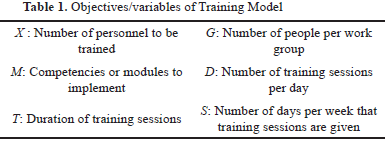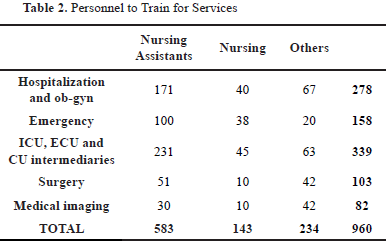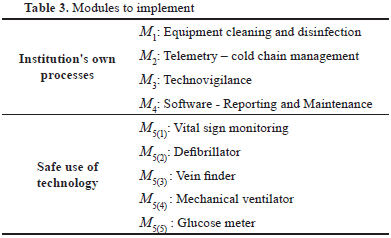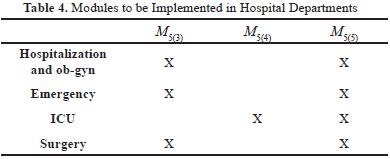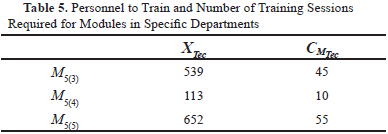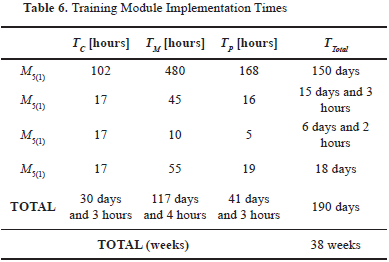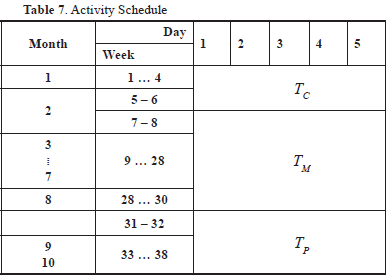Servicios Personalizados
Revista
Articulo
Indicadores
-
 Citado por SciELO
Citado por SciELO -
 Accesos
Accesos
Links relacionados
-
 Citado por Google
Citado por Google -
 Similares en
SciELO
Similares en
SciELO -
 Similares en Google
Similares en Google
Compartir
Revista Ingeniería Biomédica
versión impresa ISSN 1909-9762
Rev. ing. biomed. vol.10 no.20 Medellín jul./dic. 2016
TRAINING MODEL DESIGN IN HEALTHCARE SERVICES INVOLVING MEDICAL DEVICES
DISEÑO DE MODELO DE CAPACITACIÓN EN PROCESOS ASISTENCIALES RELACIONADOS CON DISPOSITIVOS MÉDICOS
DESENHO DE MODELO DE CAPACITAÇÃO EM PROCESSOS ASSISTENCIAIS RELACIONADOS COM DISPOSITIVOS MÉDICOS
L. B. Echeverri1, J. H. García1, J. G. Barreneche1
1 Grupo de Investigación en Bioinstrumentación e Ingeniería Clínica - GIBIC, Departamento de Bioingeniería, Facultad de Ingeniería, Universidad de Antioquia UdeA, Medellín, Colombia. Author's mailing address: echeverriramirezluz@gmail.com.
ABSTRACT
The continued improvement of quality in health care services evidences the need to implement regular training plans for nursing staff, both in institutional programs and safe use of health care technology. It is thus necessary to establish a training team to guarantee that implementation of the training does not affect the institution's provision of health care services, considering the number of people to train and the departments to which they belong, the time necessary to train the staff on a subject, and the nursing staff working group's size. This article presents a training model for nursing staff based on instructional models that encourage the construction of knowledge and skills, themselves based on the pedagogical model of the University of Antioquia and the Analysis, Design, Development, Implementation and Evaluation methodology. The model presented provides the parameters to design a training plan that impacts nursing staff without affecting the institution's services, and which is reflected in the quality of health care.
KEYWORDS: In-service training; Medical device; Biomedical technology management; Reduction of adverse events; Patient safety.
RESUMEN
El continuo mejoramiento de la calidad en la atención en salud evidencia la necesidad de ejecutar planes constantes de capacitación al personal asistencial, tanto en procesos institucionales como en uso seguro de tecnologías biomédicas. Para ello se requiere definir el personal que garantice la implementación de las capacitaciones sin afectar la prestación de servicios de salud de la institución, considerando el número de personas a capacitar y los servicios a los cuales pertenecen, el tiempo necesario para capacitarlo en un tema, y el tamaño de los grupos de trabajo del personal asistencial. En este artículo se presenta un modelo de capacitaciones dirigido al personal asistencial, diseñado a partir de modelos instruccionales que favorecen la formación del conocimiento y habilidades, sustentado en el modelo pedagógico de la Universidad de Antioquia y la metodología Análisis, Diseño, Desarrollo, Implementación y Evaluación. El modelo presentado entrega los parámetros para diseñar un plan de capacitaciones que permita impactar sobre el personal asistencial, sin afectar los servicios de la institución, y que esto se refleje en la calidad de la atención en salud.
PALABRAS CLAVE: Capacitación en servicio; dispositivos médicos; gestión de tecnología biomédica; reducción de eventos adversos; seguridad del paciente.
RESUMO
A contínua melhoria da qualidade na atenção em saúde evidência a necessidade de executar planos constantes de capacitação ao pessoal assistencial, em processos institucionais como no uso seguro de tecnologias biomédicas. Para isso, se requer definir o pessoal que garanta implementar as capacitações sem afetar a prestação de serviços de saúde da instituição, considerando o número de pessoas para capacitar e os serviços aos quais pertencem, o tempo necessário para capacitá-lo num tema, e o tamanho dos grupos de trabalho do pessoal assistencial. Neste artigo apresenta-se um modelo de capacitações dirigido ao pessoal assistencial, desenhado a partir de modelos instrutivos que favorecem a formação do conhecimento e habilidades, sustentado no modelo pedagógico da Universidade de Antioquia e a metodologia Análise, Desenho, Desenvolvimento, Implementação e Avaliação. O modelo apresentado entrega os parâmetros para desenhar um plano de capacitações que permita impactar sobre o pessoal assistencial, sem afetar os serviços da instituição, e que isto se reflita na qualidade da atenção em saúde.
PALAVRAS-CHAVE: Capacitação em serviço; Dispositivos médicos; Gestão de tecnologia biomédica; Redução de eventos adversos; Segurança do paciente.
I. INTRODUCTION
Training in health care processes involving medical devices in institutions providing health care services (in Spanish, instituciones prestadoras de servicios de atención en salud or IPSs) is focused on improving the health care knowledge, skills and abilities of technical and administrative personnel with the purpose of improving service provision. This is reflected in institutional processes due to the level of performance that can be provided by the personnel to be trained, favoring a reduction of adverse events and cost savings. Furthermore, the Joint Commission on Accreditation of Healthcare Organizations (JCAHO) requires the continuous training of all staff, especially those in clinical areas [1], [2].
In order to structure a training process, competent human resources personnel should be available and dedicated to carrying out activities aimed at establishing, maintaining and raising quality standards, which in turn leads to management with a corrective approach in healthcare processes through the development of continuous training actions. This process must be the responsibility of the clinical engineering department [1]; however, not all IPSs are able to carry it out satisfactorily since staff are not available to devote themselves exclusively to executing training plans.
Colombia has Resolution 2003 of 2014, of the Ministry of Health and Social Protection, which establishes, among other things, the standards and criteria for qualification according to the service, including priority process standards, which include the criteria for complying with the standard that all services must have a "protocol for the socialization, management and security of existing technologies in the institution and according to service" [3].
The qualification standard is supplemented by a guidebook published by the FDA in early 2016 that refers to the application of the human factor and usability engineering in medical devices [4], which highlights the importance of reducing adverse events associated with medical devices. Therefore, it is necessary to consider the engineering concept of usability, since it is also necessary to analyze the interaction between the devices and their users in order to identify whether the performance assigned to the device is the one for which it was designed according to the instructions from its manufacturer, and based on this, to identify possible causes of failures in health care.
As an alternative for continuously strengthening the capacity, skills and abilities of healthcare human resources, contributing to the improvement of the level of service delivery quality, a training model is proposed based on the constructivist educational model of the University of Antioquia and the ADDIE model (Analysis, Design, Development, Implementation and Evaluation) and aimed at health institutions with a mixed pedagogical component that includes a virtual and face-to-face phase, covering protocols specific to institutional programs such as techno-surveillance, disinfection of equipment and safe use of technology. The model presented has as its main parameters the number of personnel to be trained, the competencies to be implemented and the time it takes to enact them. Using said parameters as its basis allows the institution to guarantee their implementation without affecting healthcare staff, which is reflected in the normality of the provision of health care services.
II. METHODOLOGY
A bibliographic review of personnel training models was conducted, with findings indicating instructional training models as the foundation of organizations in the formation of knowledge, skills and attitudes: Instructional System Development, Systematic and Transitional [5], which mostly contain the basic elements of the ADDIE model from which training is systematically promoted [6]. Regarding the training models applied to health care personnel, the current health care training model at Newcastle Hospitals [7] and the Biomedical technology training model for tertiary care clinics and hospitals, nursing staff focus [8] were studied. The Kirkpatrick model was studied to validate or measure the training effectiveness [9].
Based on the above, a training model was established that integrates the educational model of the University of Antioquia (constructivist) and the ADDIE instructional model.
Constructivism is a pedagogical model based on providing the necessary tools to staff to enable them to build their knowledge, creating the possibility of abstracting concepts that channel the idea intended to arrive. It seeks to develop skills and abilities based on the concept of "knowing by doing" for staff training and appropriate the use of information and communication technologies, or ICT.
Currently, ICT in education contributes to access and equality in instruction, facilitating information management to then manage the educational model, linking knowledge and experiences in a suitable computing infrastructure to make the necessary resources available for knowledge construction.
Virtuality allows ICT to be integrated into educational models, provide comprehensive human talent training and, through the learning experience, interact with and exchange the knowledge that enables objectives to be developed. The utilization of audiovisual resources is fundamental in attracting interest in knowledge and skill building.
The ADDIE methodology comes from instructional models aimed at improving knowledge and skills previously identified and categorized as requiring special work for better performance as it is important to feed back each phase at the moment of its execution. It consists of five (5) consecutive phases [6]:
1. Analysis
The reasons justifying the need to implement the training model as well as the competencies required to be favored according to the services of the IPS in question are identified, including the target personnel and costs to be incurred. The variables that determine the model are also identified.
2. Design
The training objectives that will measure behavior in the evaluation phase and the resources required for its implementation are defined and evaluated: human, technical, infrastructure, etc. Finally, the activity schedule that governs the training model is established according to the variables previously evaluated.
3. Development
The design is translated into training, listing the activities of the training model and how they will be delivered to the staff to be trained. Course material is developed, including presentations, audio-visual aids, assessments and content to be taught to ensure achievement of the objectives.
4. Implementation
This is the execution of the training model; the necessary logistical adjustments, provision of resources and other elements for the courses are taken into account.
5. Assessment
This phase involves all the previous phases because the performance of each one is evaluated to verify that the objectives of the training model are met. It is developed as a continuous and systematic process to follow up on the personnel who, by this phase, will have already been trained, verifying the standardization of the competences implemented following the "knowing", "being" and "doing" that determine the theoretical-practical component of the training model.
III. RESULTS
The methodology described for the training model was implemented in a case study at a tertiary care hospital for a total of 960 people to train in eight different departments.
- Preliminary remarks:
- The need for health accreditation that IPSs are facing
- Patient safety, which according to the WHO covers any action or management that tends to minimize the risk of occurrence of adverse events [10].
- The human factor impact and usability engineering in medical devices as a cause of occurrence of adverse events [4].
- Preliminary diagnosis in the health institution:
The competencies of the personnel to be trained were identified according to the services and units of assistance and the technologies involved in each service.
Table 1 presents the objectives of the training protocol, and Table 2 details each service of the institution with its respective number of staff.
With the information in Table 2, the total number of people to be trained is determined: X = 960. Likewise, the size of the work groups per training shift and the number of daily training sessions are assessed: G = 12 and D = 5, respectively.
Table 3 presents the modules to be implemented, which include four of the institution's own processes and the safe use of five technologies. The modules corresponding to the institution's own processes and use of vital sign monitoring (M5(1)) and defibrillator (M5(2)) technologies are issued in all departments of the institution. Table 4 details the modules that are specific to certain departments.
The total number of training sessions for a module, CM, required to be given for all staff to receive the course is established based on the total people to train and work group size, G:
In the case of technology modules given in specific departments, the value of X is adjusted according to the total personnel corresponding to the departments involved, XTec:
Where i is each department that participates in the technology module Tec. Table 5 presents the values of the adjusted variables for the technology modules given to specific departments of the institution.
To determine the time it takes to deliver a module's training session, a training shift, the amounts of time for factors such as awareness, presentation of protocols or quick user guides, hands-on/practice components and posttraining evaluation are considered:
Where i represents the factors of each training shift.
The training team establishes the following time frames for the institution's own process modules: 10 minutes for awareness, 20 minutes to present the protocol, 20 minutes of hands-on practice and 10 minutes of evaluation. Thus, each shift of process training has a duration, TT, of one (1) hour. For the safe technology use modules, the following times are defined: 10 minutes of awareness, 10 minutes to present user guides, 30 minutes of hands-on practice and 10 minutes of evaluation. As for processes, each shift of technology training has a duration, TT, of one (1) hour.
The total time required to deliver a module to all the staff that needs to be trained, TM, is:
Knowing the variables of the model, the resources required for the training are:
- Human resources: profile of the trainer required to implement the training model; professional with knowledge of the topics to be addressed, both in institutional program protocols and safe use of identified technologies.
- Technical resources: equipment and materials necessary for the development of the themes defined in the training plan.
- Infrastructure: place or places where the training will be given; must be suitable for the processes included in the training themes and the previously identified technologies.
The training team sets the time to prepare each module, TC, taking into account the factors resulting from the resources required and the established objectives:
Where Ci represents the factors for preparing each module.
The factors considered with their respective durations are: 2 hours to be trained in each module, 7 hours to prepare the face-to-face course, 1 hour to adapt the spaces and 7 hours to set up the virtual course. Thus, each module to be implemented requires an amount of time to be prepared, TT = 17 hours.
When all training is delivered, the performance of trained personnel and compliance indicators are evaluated. Post-training time, TP, is defined in this way:
Where Tind is the time defined to measure compliance
indicators. For all implemented modules, 1 hour is defined
for this factor. The expression  refers to the performance
evaluation of the modules, which depends on the number
of people trained in each module and the size of the work
groups during each training session. The fraction
refers to the performance
evaluation of the modules, which depends on the number
of people trained in each module and the size of the work
groups during each training session. The fraction  represents 20 minutes for each work group.
represents 20 minutes for each work group.
It is important to know the times in days and weeks to facilitate the organization of the activity schedule on which the training implementation will be based, in this case, the number of training sessions per day, D, and the number of days per week, S, which the trainer will give:
Table 6 summarizes the total time to implement the training model: preparation and adaptation of each module, TC, implementation of each module, TM, and post-training time, TP. The process modules for the institution and the technologies M5(1) and M5(2), have the same durations due to being delivered to all institution staff; therefore, they are presented as one, called M, which includes the total time of the six (6) modules with the same characteristics. To determine the times in days and weeks, equations (7) and (8) were used.
Table 7 presents a general timetable on which the activities of the training protocol were developed.
The assignment of people to each training session is planned to ensure that the departments are not left without sufficient personnel to cover the provision of health services. For this, the number of personnel in each department that participates in each shift of training, XiT, is:
Where Xi is the number of personnel in each department.
Applying the values in Table 2 to equation (9), the number of personnel in each department in each training shift is determined: hospitalization and ob-gyn between 3 and 4 people between the two departments; emergency, surgery and imaging between 1 and 2 people; ICU, ECU and CU intermediaries between 4 and 5 people between the three departments.
Once the training model is designed, the following activities are carried out:
- Content of modules: what is dictated in the training sessions with the objective of contributing to the formation of the competences they wish to favor, differentiating between the virtual on-site components.
- Assembly of virtual courses: audiovisual resources for familiarization with processes and technologies, manuals and quick guides for the use of technologies, and protocols and guides for the implementation of institutional processes.
- Assembling on-site courses: adaptation of infrastructure with equipment and materials required for training.
- Pre- and post-training assessments: validate the learning acquired during training. Pre-module evaluations to identify the level of staff to be trained, and basing training management on them. Post-course evaluations assess achievement of objectives and level of knowledge acquired. These evaluations determine the possibility of certification by the University of Antioquia.
The training model is implemented in three phases: phases I and II make up the virtual component, so their implementation depends on the individual participation of the staff to train, and they do not require an established schedule.
- Virtual Diagnostics: The staff is provided with training in the management of the Ude@ Moodle platform developed by the University of Antioquia through individual registration, assigning usernames and passwords, and the provision of general information on each module of the model training sessions. In compliance with the main objective of this phase, before starting each module, a preliminary evaluation is carried out in order to identify the staff's knowledge on the subject and their shortcomings, and according to these results adjust the on-site training phase.
- Virtual training: Once the preliminary evaluation of each module is made, its content is enabled, making it possible to interact extensively with protocols, manuals, quick guides, presentations and audiovisual material.
- On-site training: This is a theoretical-practical training where the content of each module is presented with a special focus based on the analysis conducted in phase I. At the end of each training session, a new evaluation is carried out to measure the effectiveness of the training and ease of learning for the attendees. The theoretical component complements the information previously addressed in phase II, and the practical component includes the presentation of processes, patterns and simulators for safe use of the technology and interaction with technologies and processes according to the module being implemented.
In the last phase of the training protocol, a posttraining evaluation is carried out to identify the levels of abstraction and satisfaction of the trained personnel, which, together with the completion of the virtual training, determines whether personnel are qualified to apply for certification by the University of Antioquia. It also allows objective achievement indicators to be measured and provides a way to determine how this is reflected in work performance and the provision of health services.
IV. DISCUSSION
IPSs are in need of trained personnel to improve quality of care, which translates into ensuring patient safety as a fundamental principle of health care.
This need, in turn, becomes the way for departments to comply with qualification standards and criteria, which are regulated in Colombia by Resolution 2003 [3], and achieve health systems accreditation, of interest to all institutions due to the regulatory requirements that structure public policies and human management [2]. However, despite its often being a requirement for all institutions, it is not possible to implement with satisfaction on the part of the area in charge, since the continuum of care does not make it possible to include adequate time for training in nursing staff work plans.
With this training model, it is possible to resolve the inconvenience of institutional staff availability by ensuring that in all training sessions, which are designed with a maximum duration of one hour, the number of people absent from each service is a maximum of three in departments with a greater quantity of personnel.
This model is completely flexible, so it can be extrapolated to any IPS required to implement it. It conforms to the target number of staff to train; if, for example, there is a need for it to be implemented in a more personalized way, working groups with less staff can be created and training shifts and other variables can be established. Also, the modules to implement are defined by the requirements of the institution in terms of the skills they want to promote.
In addition to the objectives that arise during the design phase of the training plan model to be implemented through the University of Antioquia, it is possible for the University of Antioquia to grant attendance and knowledge certification on the competencies developed in the modules to all personnel who meet the following criteria: receive a minimum of 20 hours of training with the different modules, including virtual and on-site components, and demonstrate 80% of qualifications met in the different evaluations carried out during the training plan.
V. CONCLUSION
The constructivist model based on the ADDIE methodology based on which the training plan was developed is adapted to health institutions seeking to promote the skills of health care staff in a reliable way, with the support of educational experience and specialized training offered by the University of Antioquia training team.
The implemented training plan provides a training team dedicated exclusively to the health institution, which promotes the development of competences and makes it possible to monitor the staff being trained. This facilitates the routing, or rerouting, of the model's implementation based on identified requirements, whether in the design phase or during the implementation phase.
ACKNOWLEDGMENTS
This work was supported in part by the General Royalties System (in Spanish, Sistema General de Regalías), of the Republic of Colombia through the project "Strengthening of the technological platform for specialized training in the area of health and development of biomedical technology," under the code RutaN-139C.
REFERENCES
[1]. Pallikarakis N., Bliznakov Z. Hospital Technology Management, en: Clinical Engineering: From Devices to Systems, R. Miniati, E. Iadanza, F. Dori., Eds. London: Elsevier, Academic Press, 47-61. 2016. [ Links ]
[2]. Wear J.O. In-service Education, en: Clinical Engineering Handbook, J. F. Dyro, Eds. Burlington, MA: Elsevier, Academic Press, 315-37, 2004. [ Links ]
[3]. Ministerio de Salud y Protección Social, Resolución 2003 de 2014. [ Links ]
[4]. FDA. Applying Human Factors and Usability Engineering to Medical Devices. Guidance for Industry and Food and Drug Administration Staff. 2016. 49 p. [ Links ]
[5]. Chand S. Models of Training Employees: Steps, Transitional and Instructional System Development Model (2016). En: http://www.yourarticlelibrary.com/training-employees/modelsoftraining-employees-steps-transitional-and-instructionalsystemdevelopment-model/29548/. [ Links ]
[6]. Bigai E. Entornos virtuales de aprendizaje. Modelo de diseño instruccional ADDIE (2013). En: https://es.scribd.com/doc/149845251/modelos-de-diseno-instruccional-modelo-ADDIE. [ Links ]
[7]. Webster J. Medical Devices Training Policy. Royal Cornwall Hospitals NHS, V. 1.9, mayo de 2013. [ Links ]
[8]. Franco G.A., Jaramillo D., Barreneche J.G. Modelo de capacitación de tecnología biomédica para clínicas y hospitales de tercer nivel, enfocado en personal asistencial. Revista Ingeniería Biomédica, 9(18), 139-144, julio-diciembre de 2015. [ Links ]
[9]. Donald L., James D., Wendy K. Kirkpatrick. "The Kirkpatrick Model," Kirkpatrick Partners, 2009-2016. En: http://www.kirkpatrickpartners.com/OurPhilosophy/TheKirkpatrickModel/tabid/302/Default.aspx. [ Links ]
[10]. WHO. Patient safety. En: http://www.who.int/patientsafety/en/. [ Links ]











 texto en
texto en 

